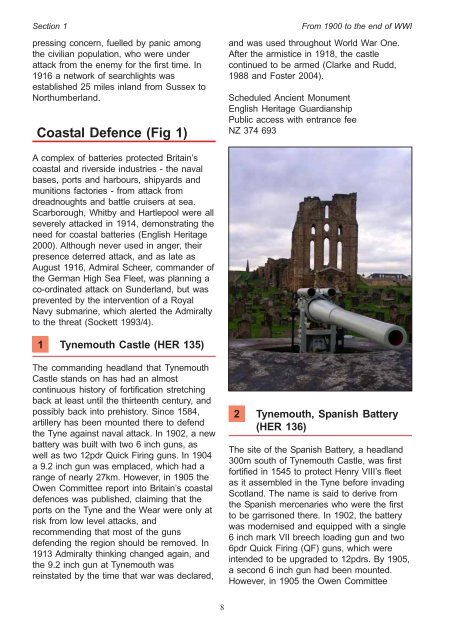TWENTIETH CENTURY DEFENCE SITES of TYNE and WEAR
TWENTIETH CENTURY DEFENCE SITES of TYNE and WEAR
TWENTIETH CENTURY DEFENCE SITES of TYNE and WEAR
You also want an ePaper? Increase the reach of your titles
YUMPU automatically turns print PDFs into web optimized ePapers that Google loves.
Section 1 From 1900 to the end <strong>of</strong> WWI<br />
pressing concern, fuelled by panic among<br />
the civilian population, who were under<br />
attack from the enemy for the first time. In<br />
1916 a network <strong>of</strong> searchlights was<br />
established 25 miles inl<strong>and</strong> from Sussex to<br />
Northumberl<strong>and</strong>.<br />
Coastal Defence (Fig 1)<br />
A complex <strong>of</strong> batteries protected Britain’s<br />
coastal <strong>and</strong> riverside industries - the naval<br />
bases, ports <strong>and</strong> harbours, shipyards <strong>and</strong><br />
munitions factories - from attack from<br />
dreadnoughts <strong>and</strong> battle cruisers at sea.<br />
Scarborough, Whitby <strong>and</strong> Hartlepool were all<br />
severely attacked in 1914, demonstrating the<br />
need for coastal batteries (English Heritage<br />
2000). Although never used in anger, their<br />
presence deterred attack, <strong>and</strong> as late as<br />
August 1916, Admiral Scheer, comm<strong>and</strong>er <strong>of</strong><br />
the German High Sea Fleet, was planning a<br />
co-ordinated attack on Sunderl<strong>and</strong>, but was<br />
prevented by the intervention <strong>of</strong> a Royal<br />
Navy submarine, which alerted the Admiralty<br />
to the threat (Sockett 1993/4).<br />
1 Tynemouth Castle (HER 135)<br />
The comm<strong>and</strong>ing headl<strong>and</strong> that Tynemouth<br />
Castle st<strong>and</strong>s on has had an almost<br />
continuous history <strong>of</strong> fortification stretching<br />
back at least until the thirteenth century, <strong>and</strong><br />
possibly back into prehistory. Since 1584,<br />
artillery has been mounted there to defend<br />
the Tyne against naval attack. In 1902, a new<br />
battery was built with two 6 inch guns, as<br />
well as two 12pdr Quick Firing guns. In 1904<br />
a 9.2 inch gun was emplaced, which had a<br />
range <strong>of</strong> nearly 27km. However, in 1905 the<br />
Owen Committee report into Britain’s coastal<br />
defences was published, claiming that the<br />
ports on the Tyne <strong>and</strong> the Wear were only at<br />
risk from low level attacks, <strong>and</strong><br />
recommending that most <strong>of</strong> the guns<br />
defending the region should be removed. In<br />
1913 Admiralty thinking changed again, <strong>and</strong><br />
the 9.2 inch gun at Tynemouth was<br />
reinstated by the time that war was declared,<br />
8<br />
<strong>and</strong> was used throughout World War One.<br />
After the armistice in 1918, the castle<br />
continued to be armed (Clarke <strong>and</strong> Rudd,<br />
1988 <strong>and</strong> Foster 2004).<br />
Scheduled Ancient Monument<br />
English Heritage Guardianship<br />
Public access with entrance fee<br />
NZ 374 693<br />
2 Tynemouth, Spanish Battery<br />
(HER 136)<br />
The site <strong>of</strong> the Spanish Battery, a headl<strong>and</strong><br />
300m south <strong>of</strong> Tynemouth Castle, was first<br />
fortified in 1545 to protect Henry VIII’s fleet<br />
as it assembled in the Tyne before invading<br />
Scotl<strong>and</strong>. The name is said to derive from<br />
the Spanish mercenaries who were the first<br />
to be garrisoned there. In 1902, the battery<br />
was modernised <strong>and</strong> equipped with a single<br />
6 inch mark VII breech loading gun <strong>and</strong> two<br />
6pdr Quick Firing (QF) guns, which were<br />
intended to be upgraded to 12pdrs. By 1905,<br />
a second 6 inch gun had been mounted.<br />
However, in 1905 the Owen Committee

















